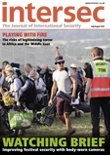Chemical warfare
Doctor Michael Crowley and Professor Malcolm Dando on the importance of preventing the misuse of chemicals
Since its entry into force in 1997 the Chemical Weapons Convention (CWC) and its implementing body, the Organisation for the Prohibition of Chemical Weapons (OPCW), have become the most significant and effective mechanisms for collective global action combating the development, stockpiling and use of chemical weapons against both armed forces and civilians under any circumstances. The OPCW and its 193 Member States have been remarkably successful in their efforts to identify and destroy existing (mainly Cold War era) chemical weapons arsenals and production facilities around the world, with all declared chemical weapons stockpiles due to be eliminated by 2023. Despite such success, chemical weapons have clearly not been consigned to history. Indeed the unstable international security environment and the changing nature of conflict – particularly where law enforcement, repression, counter insurgency and internal armed conflict meet – could fuel a desire by certain States to retain and use existing clandestine chemical weapons, as well as increase State interest in creating new types of weapons. Furthermore, a broader range of actors – including States, armed opposition groups and terrorist organisations – may seek to employ diverse toxic chemicals as improvised weapons.
As the OPCW strives to uncover remaining chemical weapons stockpiles, respond to attacks and prevent the development of new weapons, it must do so without detrimentally effecting the innumerable legitimate uses of toxic chemicals for peaceful purposes, nor attempt to unduly constrain the continuing rapid and revolutionary developments in and convergence of chemistry, biology and other relevant scientific disciplines and associated technologies, which will undoubtedly bring societal benefits, but also have potentially malign applications. The quinquennial CWC Review Conference in November 2018, with its explicit mandate to examine long-term issues of concern to the OPCW regarding implementation of the CWC in a strategic manner, and to “take into account any relevant scientific and technological developments”, is clearly the most appropriate forum for the CWC States Parties and concerned arms control and scientific communities collectively to address these tangled issues. One area of continuing controversy concerns how the Organisation should address the threat arising from potential development, proliferation and use of law enforcement weapons employing central nervous system (CNS) acting chemical agents.
CNS-acting law enforcement weapons can be described as weapons potentially employing a disparate range of substances including pharmaceutical chemicals, bio-regulators and toxins intended to effect the body’s central nervous system purportedly to cause prolonged but non-permanent disability. Although such weapons are envisaged as acting on the CNS to produce unconsciousness, sedation, hallucination, incoherence, disorientation or paralysis; with inappropriate doses, serious injury or death can result – as illustrated in the only confirmed large-scale use of such weapons to date.
On 26 October 2002, Russian Spetsnaz Special Forces, in their attempt to save 900 hostages held in a Moscow theatre by armed Chechen separatists, employed a secret CNS-acting weapon. Following mass sedation of the occupants, the Special Forces stormed the theatre and shot all the separatists. Although the bulk of the hostages were freed, more than 120 of them were killed by the chemical agent, and many more continue to suffer long-term health problems. A trace analysis undertaken by researchers from the UK’s Defence Science and Technology Laboratory (DSTL) of extracts of clothing and urine from survivors of the Moscow theatre siege concluded that the CNS acting weapon comprised a mixture of two anaesthetics, carfentanil and remifentanil. To this day, the Russian authorities refuse to publicly disclose full details of the weapon they employed or provide any information regarding the nature and levels of such weapons they may have developed or stockpiled.
Proponents of such weapons have long advocated their development and use in extreme law enforcement scenarios, such as the Moscow siege, where there is a need to incapacitate an individual or a group rapidly and completely without causing permanent disability or fatality. Certain proponents have also raised the possibility of using them as a tool in a variety of military operations, especially in locations where fighters and civilians are in close proximity or intermingled.
Scientific and medical professional associations, arms control organisations, international legal experts, and human rights and humanitarian organisations, as well as a growing number of States, have criticised research and development of such weapons, contending that their use presents potentially grave dangers to health and well-being. The British Medical Association concluded that“[t]he agent whereby people could be incapacitated without risk of death in a tactical situation does not exist and is unlikely to in the foreseeable future. In such a situation, it is and will continue to be almost impossible to deliver the right agent to the right people in the right dose without exposing the wrong people or delivering the wrong dose.”
Additional concerns that have been raised are the risk of ‘creeping legitimisation’ of CNS acting law enforcement weapons with the erosion of the norm against the weaponisation of toxicity; the dangers of such weapons proliferation to both State and non-State actors; their potential use as a lethal ‘force multiplier’; their employment to facilitate torture and other human rights violations; the further misuse and militarisation of the life sciences; the potential for States to use CNS-acting law enforcement weapons development as a cover for covert offensive chemical weapons programmes; and the danger of creating a slippery slope that could lead to chemical warfare.
Disquiet about CNS-acting law enforcement weapons is further exacerbated by concern that rapid advances in relevant chemical and life sciences, particularly genomics, synthetic biology, medical pharmacology and neuroscience, will be harnessed to their development. In a 2012 study, the Royal Society gave warning of “active interest in performance degradation applications of neuroscience for both military and law enforcement purposes” and highlighted “indications of interest among a number of States in the development and use of incapacitating chemical agents.”
Crowley and Dando subsequently conducted a survey of research by State, academic and commercial entities potentially applicable to the study or development of CNS-acting law enforcement weapons. The survey documented evidence of continued research in relevant fields by Russian scientists following the Moscow theatre siege. This included computer modelling of the application of “calmatives” against groups of individuals in enclosed spaces and exploration of the interaction of potential CNS acting chemical agents with human receptor sites. The survey also highlighted the possession by China and the previous reported use by Israel of CNS-acting weapons targeting individuals, while States including the Czech Republic, India, Iran, the UK and US had conducted dual-use research since 1997 that was potentially applicable to the study or development of CNS-acting law enforcement weapons.
As toxic chemicals, CNS acting chemical agents clearly come under the scope of the CWC; their use as weapons in armed conflict is therefore prohibited. Yet, there are differing interpretations among States, academics and legal scholars as to whether certain such weapons could be legitimately used for law enforcement. Regrettably, no policy making organ of the OPCW has yet clarified whether these weapons can or cannot legitimately be employed for such purposes and, if so, under what circumstances and with what constraints. Consequently CWC States Parties are left to interpret the scope and nature of their obligations in this area, with the danger that a “permissive” interpretation may evolve.
Although the UK, US and some other countries that previously conducted research in these areas have now formally declared that they are not developing and do not possess CNS-acting weapons, some States known to have developed and/or employed such weapons – notably the Russian Federation, China and Israel – remain silent.
In recent years, there have been concerted attempts by a growing number of States, led by Australia and Switzerland, to encourage the OPCW to resolve the ambiguities concerning the development and use of these weapons. A significant advance came in December 2015 when Australia and 21 co-sponsoring States issued their paper Aerosolisation of Central Nervous System-Acting Chemicals for Law Enforcement Purposes calling on States Parties to make known their national positions on the use of such chemicals in law enforcement and promoting OPCW discussions to develop “concrete recommendations for how to address [these] chemicals in a way that would significantly advance one of the OPCW’s priorities – preventing the re-emergence of chemical weapons.”
Momentum is clearly building for action on CNS-acting law enforcement weapons, with a growing number of States formally forswearing use of these agents for law enforcement purposes and at least 39 now calling for OPCW-wide consultations. In July 2018 the OPCW Open Ended Working Group tasked with preparations for the November Review Conference, noted “the increasing concern… among States Parties that toxic chemicals which target the central nervous system (CNS), and their potential use in aerosolised form in certain law enforcement scenarios, [to] undermine the object and purpose of the Convention, as well as the OPCW’s Scientific Advisory Board conclusion that CNS-acting chemicals cannot be used safely for law enforcement purposes” and recommended that “the Organisation should commence an inclusive policy discussion in its [policy making organs] without pre-empting its outcome.”
Because the possession and use of CNS-acting law enforcement weapons currently appears to be restricted to a relatively small number of countries, there is still time for the international community to deal with this threat. The OPCW has a window of opportunity, in which it can take a precautionary, preventative approach: closely monitoring developments in relevant dual-use chemical and life science research, and prohibiting or at the very least severely restricting development, acquisition, stockpiling and use of CNS-acting law enforcement weapons. If the Review Conference does not act decisively on this issue, there is a danger that an ever growing number of countries will seek to harness advances in relevant scientific disciplines for CNS-acting law enforcement weapons development programmes. This in turn, may convince other States to conduct their own CNS weapons research or potentially explore an even broader range of chemical agents, with the danger of a consequent spiral of actions and reactions that could weaken and eventually erode the prohibition on chemical weapons.
Professor Malcolm Dando (Honorary Visiting Senior Research Fellow, Bradford University) held UK Ministry of Defence funded fellowships in Operational Research in the seventies. Since then he has worked on arms control and disarmament, particularly on chemical and biological issues.
Dr Michael Crowley (Leverhulme Emeritus Fellow, Bradford University) has worked for 25 years on arms control, security and human rights issues, notably in relation to the regulation, use and misuse of conventional arms, security equipment and “less lethal” weapons. Together they produced the recently published Royal Society of Chemistry book, Preventing Chemical Weapons: Arms Control and Disarmament as the Sciences Converge, co-edited by L. Shang.









